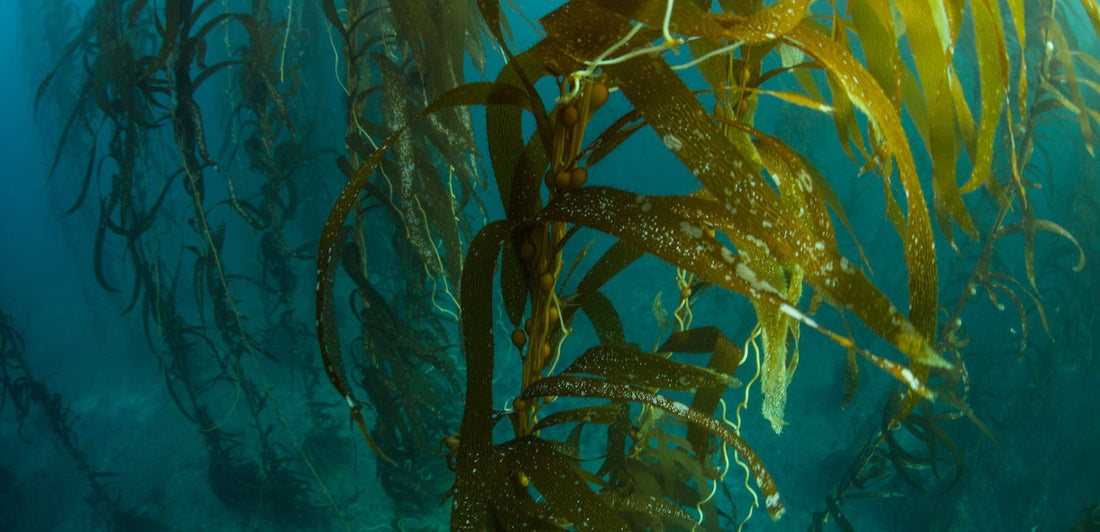Rainforests like the Amazon are often held up as critical ecosystems, their wellbeing and survival crucial to the struggle against climate breakdown. There’s no doubt that deforestation in the Amazon and across many of the world’s tropical landmasses is troubling, but for too long the health of our planet’s underwater forests has been omitted from conversations around global warming and habitat loss, this despite them sequestering as much C02 as the entire Amazon rainforest.
This oversight perhaps comes from most people not being able to visit the ocean’s forests in person, to witness first-hand these incredible subaquatic worlds. Thanks to scientists and oceanographers, all that is changing, as we begin to understand how crucial these natural wonders are to all life systems.
Let us dive together beneath the surface, to explore these ethereal worlds.
What Are Ocean Forests?
The term ocean forest is mainly used to describe large clusters of kelp (seaweed). Kelp can grow at up to 50cm-a-day and reach lengths of 80m+, rising from the seabed to provide a veritable underwater jungle habitat for sea creatures such as sea otters, sea lions, and thousands of other species.

Although they have evolved over millions of years to resemble plants, kelp’s 100+ variations are actually an ancient form of algae. In many coastal communities they have long been central to human survival and prosperity, due to their diverse applications. Seaweed is a staple of Japanese diets, featuring in sushi and many other traditional dishes. From the Mediterranean to the Americas it has been used for medicinal purposes, with bullwhip kelp even being harnessed by inuits to make fishing lines, nets, ropes, harpoon lines and anchor lines.

What Threatens Them?
Unfortunately, many of these lush underwater jungles are finding it hard to flourish in an ocean whose resources are more sought after than ever. According to a UN report, between 40%-60% of the ocean’s kelp forests have been degraded, some to the point of non-existence, this despite global warming making Arctic waters more hospitable for kelp forests. So what are the drivers causing this worrying decline? Who’s responsible?
Bottom Trawling & Overfishing
Harmful fishing practices are one of the main drivers of ocean forest destruction. But we’re not talking about traditional small fishing boats whose catches have remained steady for generations. Moreover, we are referring to commercial fishing practices like bottom trawling.
This is the use of huge cone-shaped nets that dredge the ocean floor. It is a highly productive way of catching large quantities of fish or crabs that feed close to the bottom of the sea. Productive it may be, but it is equally destructive for the ocean habitats it scours. Such weighted nets harvest everything in their path, from precious coral reefs to equally vital kelp forests. The repercussions of this for any living entity that relies on the seabed are obvious.

Even when bottom trawling is not degrading the seabed, general overfishing can also have a major negative impact on kelp, which relies on delicate natural balances in saltwater ecosystems. For example, when large predatory species like lobsters are removed from kelp forest habitats, there is nothing to stop the proliferation of sea urchin colonies, which consume kelp to the point of total destruction, leaving behind what are known as sea urchin barrens.

Kelp Harvesting
There is currently a huge drive to find alternative fuel sources and low impact materials capable of weaning humanity off fossil fuels. Many companies are turning to natural resources like seaweed as a possible renewable alternative, in much the same way that trees are used to create renewable products.
While there are sustainable ways of farming kelp, there are others which simply decimate it, in much the same way that intensive farming practices erode or poison soil. A recent study in Scotland found that the potential harvesting of kelp stock in the country’s waters would have catastrophic impacts on the local marine ecosystem and the coastal communities that rely on it. People hoping to cultivate seaweed should learn from the mistakes that arable farmers made before them, rather than perpetuating a cycle of exploitative agriculture.
People hoping to cultivate seaweed should learn from the mistakes that arable farmers made before them.
Ocean Warming
As was previously mentioned, kelp forests can actually increase in number thanks to the rises in ocean temperatures caused by climate change. However, more in-depth research has found that while the number of underwater forests may increase in line with rising temperatures, their quality and strength will likely decrease, making them less effective at benefitting the ecosystems they inhabit.
That’s where sustainable brands like TWOTHIRDS can make a huge difference, not only keeping waste plastic out of the ocean, but also minimising our environmental impact, so that oceans don’t bear the brunt of keeping the planet, and kelp, cool.
How Can We Care For Kelp?

Another way of caring for these forests of the sea is to actively help them regenerate. There are many organisations like SeaForester which work tirelessly to help restore lost underwater forests. They empower teams around the world to regenerate and care for kelp, using a multitude of different planting techniques.
While such organisations do invaluable work, our collective responsibility as passengers on mother earth is to mitigate climate change, to stop ocean acidification taking place, which really would be catastrophic to life as we know it.
How Does Kelp Care For Us?

Kelp forests existed before humans and they will no doubt outlive us as well. Think of them as ocean sentinels, there to let us know when we have mistreated the sea, hinting at how we might win back its trust. As we find out that kelp helps sequester large amounts of C02, provides crucial habitats for thousands of species, protects shorelines from storm surges, and is a nutritious food source, it becomes clear that this is a natural wonder worth caring for, not just because kelp forests deserve to flourish, but because we desperately need them to.









